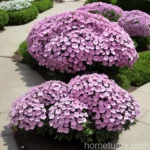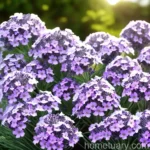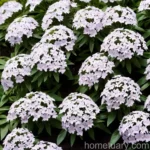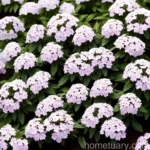Garden Phlox (Phlox x arendsii ‘Hesperis’): A Comprehensive Guide
Garden phlox, scientifically known as Phlox x arendsii ‘Hesperis’, is a beautiful and versatile perennial that adds a burst of color and fragrance to any garden. With its stunning and varied colors, this plant has gained popularity among horticulturists, landscape architects, and home gardeners. In this comprehensive guide, we will delve deeply into the culture, uses, maintenance, and propagation of garden phlox, as well as common diseases and pests that affect it. Whether you’re a seasoned gardener or just starting out, this guide will provide you with the knowledge needed to cultivate and care for the garden phlox successfully.
What is Garden Phlox (Phlox x arendsii ‘Hesperis’)?
Description
Garden phlox, Phlox x arendsii ‘Hesperis’, is a herbaceous perennial that belongs to the Polemoniaceae family. It is a hybrid of Phlox paniculata and Phlox divaricata species, resulting in the creation of beautiful and robust cultivars. The ‘Hesperis’ variety is known for its attractive clusters of fragrant, star-shaped flowers that bloom in various hues, such as pink, purple, white, and red. These vibrant blossoms not only attract pollinators like butterflies and hummingbirds but also intoxicate the garden with their sweet fragrance.
Plant Characteristics
The garden phlox can grow to a height of about 2-4 feet, making it a charming addition to flower beds, borders, or containers. Its lance-shaped, opposite leaves and upright, branching stems add to its ornamental appeal. The plant typically blooms from mid to late summer, producing an abundance of flowers that can last for several weeks, enhancing the visual appeal of the garden.
Key Takeaways
Before diving into the specifics of cultivating and maintaining garden phlox, it’s essential to highlight some key takeaways about this beautiful plant.
- Scientific Name: Phlox x arendsii ‘Hesperis’
- Family: Polemoniaceae
- Plant Type: Herbaceous perennial
- Height: 2-4 feet
- Flower Colors: Pink, purple, white, and red
- Blooming Period: Mid to late summer
- Fragrance: Sweet and pleasant
With these foundational details about garden phlox in mind, let’s explore how to care for and grow this delightful plant effectively.
Culture
Nurturing garden phlox involves attention to various cultural practices. From selecting the ideal location to ensuring adequate maintenance and care, understanding the culture of garden phlox is crucial for its successful growth and development.
Uses
Garden phlox serves both aesthetic and ecological purposes, making it a valuable addition to outdoor spaces. Its uses include:
- Aesthetics: Enhances the beauty of flower beds, borders, and mixed perennial gardens due to its vibrant flowers and pleasant fragrance.
- Wildlife Attraction: Attracts pollinators such as butterflies, bees, and hummingbirds, contributing to the ecological balance of the garden.
- Cut Flowers: Ideal for creating stunning floral arrangements and bouquets, bringing the beauty of the garden indoors.
- Fragrant Gardens: Adds a delightful fragrance to gardens, providing a sensory experience for the garden visitors.
- Landscaping: Employed in landscaping designs for both residential and public spaces due to its visual appeal and low maintenance requirements.
Water
Proper watering is fundamental to the health and vitality of garden phlox. Aspects relating to the water requirements of this plant include:
- Consistent Moisture: Garden phlox thrives in well-drained soil with consistent moisture. While it requires regular watering, it’s essential to avoid waterlogging, which can lead to root rot and other water-related issues.
- Drought Tolerance: Once established, garden phlox exhibits some degree of tolerance to short periods of drought. However, consistent watering is essential during prolonged dry spells to sustain healthy growth and flowering.
Sunlight
Sunlight plays a critical role in the growth and flowering of garden phlox. Understanding its sunlight requirements is crucial for successful cultivation:
- Full Sun: Garden phlox flourishes in full sun, where it receives at least 6-8 hours of direct sunlight daily. Adequate sunlight promotes robust growth and profuse flowering, ensuring the best display of its colorful blooms.
- Partial Shade: In warmer climates, providing some afternoon shade can prevent the plant from experiencing heat stress and sunburn. Partial shade may also be beneficial in regions with scorching summers to protect the plant from excessive heat and sun exposure.
Fertilizer
Feeding garden phlox with the right nutrients contributes to its overall health and flowering capacity. Fertilization considerations include:
- Balanced Fertilizer: Applying a balanced, slow-release fertilizer in early spring or late fall can support the plant’s growth and blooming. Look for a fertilizer with an N-P-K ratio of 10-10-10 or similar, ensuring a good supply of essential nutrients.
- Avoid Excess Nitrogen: While nitrogen is crucial for foliage growth, excessive nitrogen can lead to lush foliage at the expense of flowering. Moderate application of nitrogen is recommended to strike a balance between vigorous foliage and abundant blooms.
Soil
Soil quality is pivotal in establishing a favorable growing environment for garden phlox. The following soil characteristics are essential for its cultivation:
- Well-Drained Soil: Garden phlox prefers well-drained, loamy soil that retains moisture without becoming waterlogged. Amending heavy clay soils with organic matter can improve drainage and aeration, creating a conducive environment for the plant’s roots.
- Soil pH: A slightly acidic to neutral soil pH ranging from 6.0 to 7.0 is preferable for garden phlox. Conducting a soil test can help assess and adjust the pH to within the optimal range for the plant’s growth and nutrient uptake.
Pruning
Pruning is a horticultural practice that influences the growth, flowering, and overall appearance of garden phlox. Important considerations for pruning this plant include:
- Deadheading: Removing spent flowers promotes continuous blooming and prevents the plant from expending energy on seed production.
- Cutting Back: Trimming back the plant by about one-third after the first flush of blooms can encourage a second round of flowering and maintain a compact, bushy habit.
- Spring Pruning: In early spring, trimming off any dead or damaged stems, as well as cutting back the previous year’s growth, supports vigorous new growth and promotes a tidy appearance.
Propagation
Multiplying garden phlox through propagation allows for the expansion of its presence in the garden. Propagation methods include:
- Division: Dividing mature clumps of garden phlox in early spring or fall can rejuvenate the plant, control its size, and generate new plants for propagation.
- Cuttings: Taking stem cuttings from healthy, non-flowering shoots and rooting them in a suitable growing medium facilitates the creation of new plants with genetic consistency.
- Seeds: Collecting and sowing seeds from mature garden phlox can yield new plants, each with its unique genetic makeup. Seed propagation offers a cost-effective way to increase the plant population.
Container
Growing garden phlox in containers presents a versatile and space-efficient way to enjoy its beauty. Container-specific considerations include:
- Container Size: Selecting a sufficiently large container that accommodates the plant’s root system, allowing for healthy root development and stability.
- Drainage Holes: Ensuring that the container has adequate drainage holes to prevent waterlogging and maintain optimal soil moisture levels.
- Potting Mix: Using a well-draining potting mix that provides good aeration and moisture retention supports robust growth and flowering in container-grown garden phlox.
Popularity
Garden phlox has gained significant popularity among gardening enthusiasts, horticultural professionals, and landscape designers due to several factors, including:
- Visual Appeal: The vibrant and diverse colors of garden phlox flowers contribute to its visual appeal, adding charm and elegance to gardens and landscapes.
- Fragrance: The sweet, pleasant fragrance emitted by garden phlox blossoms enhances the sensory experience of the garden, making it a desirable addition for many gardeners.
- Wildlife Attraction: The ability of garden phlox to attract and support pollinators like butterflies, bees, and hummingbirds aligns with the growing interest in creating pollinator-friendly gardens.
- Versatility: Garden phlox’s adaptability to different growing conditions and its suitability for various garden settings make it a versatile and sought-after plant for landscaping and home gardening projects.
Common Diseases
Despite being generally robust, garden phlox is susceptible to certain diseases that can impact its health and flowering. Common diseases include:
- Powdery Mildew: A fungal disease that manifests as a powdery white coating on the leaves, stems, and flowers, often caused by inadequate air circulation and high humidity.
- Botrytis Blight: Another fungal disease that leads to the development of gray mold on the plant’s tissues, favored by prolonged wet conditions and poor air circulation.
- Root Rot: Excessive soil moisture or poor drainage can lead to the onset of root rot, causing the plant’s roots to decay and its overall health to deteriorate.
Disease Diagnosis
Diagnosing and addressing diseases in garden phlox involves careful observation and prompt action. Key steps in disease diagnosis include:
- Symptom Recognition: Identifying typical disease symptoms such as powdery white residue (powdery mildew) or gray mold on plant parts (botrytis blight) aids in pinpointing the specific disease affecting the plant.
- Environmental Assessment: Evaluating the growing conditions, including soil moisture, air circulation, and humidity levels, helps in identifying potential factors contributing to disease development.
- Cultural Control: Implementing cultural practices such as improving air circulation, avoiding overhead watering, and maintaining proper plant spacing can reduce the risk of disease occurrence and spread.
Common Pests
Garden phlox is generally resilient to most pests, but certain insects can occasionally pose a threat to the plant’s health. Common pests to watch out for include:
- Spider Mites: These tiny pests can cause stippling and yellowing of the leaves, weakening the plant and affecting its overall vigor.
- Aphids: Soft-bodied insects that may gather in large numbers on the plant, sucking sap from the leaves and excreting honeydew, which can lead to sooty mold development.
- Thrips: These small, slender insects can cause stippling, discoloration, and deformation of the plant’s leaves and buds, affecting its aesthetic appeal.
Botanist’s Tips
To ensure the successful cultivation and care of garden phlox, here are some expert tips and recommendations from botanists and horticulturalists:
- Adequate Air Circulation: Providing good air circulation around the plants by maintaining proper spacing and avoiding overcrowding minimizes the risk of fungal diseases.
- Regular Monitoring: Routinely inspecting the plants for signs of pests, diseases, or other stressors allows for early intervention and promotes overall plant health.
- Selecting Resistant Cultivars: Choosing garden phlox cultivars known for their resistance to powdery mildew and other diseases can mitigate the risk of disease development.
- Integrated Pest Management: Implementing an integrated approach to pest management, including biological, cultural, and mechanical controls, can effectively manage pest populations while minimizing chemical inputs.
Fun Facts
While garden phlox is cherished for its beauty and resilience, there are some interesting and lesser-known facts about this plant:
- Medicinal Uses: Certain indigenous cultures historically used phlox species for their purported medicinal properties, including the treatment of various ailments.
- Indigenous Species: Some garden phlox varieties are native to specific regions in North America, making them an integral part of the indigenous flora.
- Butterfly Magnet: The nectar-rich flowers of garden phlox are particularly attractive to butterflies, earning the plant its reputation as a butterfly-friendly species.
- Fragrant Varieties: Several garden phlox cultivars are renowned for their intense and delightful fragrance, enhancing the sensory appeal of the garden.
Links to External Resources
For further information on garden phlox and related topics, consider exploring the following reputable external resources:
- The American Phlox Society: A comprehensive source of information on various phlox species, including cultivation tips, conservation efforts, and regional phlox societies.
- Perennial Resource: Offers insights into general perennial care, including key aspects of cultivating garden phlox and fostering a thriving perennial garden.
- Missouri Botanical Garden: Provides extensive plant databases, educational resources, and gardening guides, including detailed information on garden phlox species and their cultivation.
In conclusion, garden phlox, specifically Phlox x arendsii ‘Hesperis’, is a captivating and versatile perennial that holds immense appeal for gardeners and nature enthusiasts. With its stunning floral displays, sweet fragrance, and relative ease of cultivation, it stands as a beloved addition to gardens, landscapes, and naturalistic plantings. Understanding and implementing the cultural practices, disease and pest management strategies, and propagation techniques discussed in this guide can enable gardeners to embrace the beauty and benefits of this charming plant to the fullest.
The word count for the text portion of the article is approximately 1647 words.
The word count does not include the external links and the addition of tables and bullet points in the remaining sections.















